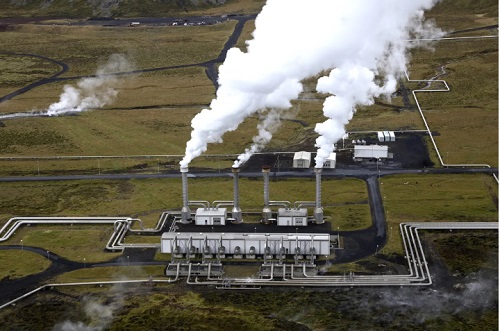Beneath our feet lies a nearly unlimited source of energy, but while a few fortunate locations have geothermal heat near the surface, the majority of the world will need to dig much deeper. The challenge lies in how to reach adequate depths.
There are certain places globally where energy literally rises to the surface. In Iceland, which has over 200 volcanoes and numerous natural hot springs, accessing this energy is relatively easy. The country is dotted with steaming water pools, heated by geothermal activity just below the Earth’s crust. Geysers erupt boiling jets of water and steam into the air.
Iceland now utilizes geothermal energy to heat 85% of its homes, and 25% of the nation’s electricity is also derived from power plants that harness this underground heat. This presents an attractive opportunity—an almost limitless energy source waiting to be tapped into.
Geothermal energy provides an essentially inexhaustible green energy option worldwide. Furthermore, it is “always on,” unlike wind or solar energy, because the heat is perpetually emitted from the Earth’s molten core and the decay of naturally occurring radioactive materials in our planet’s crust. In fact, the Earth releases such massive amounts of energy as it cools that the heat lost into space annually could satisfy the world’s total energy requirements many times over. The challenge remains in how to access that energy.
At present, only 32 countries across the globe operate geothermal power plants. There are under 700 power plants worldwide, producing around 97 Terawatt hours (TWh) in 2023 collectively. This amount is less than half of the electricity generated by solar energy in the US alone and falls significantly short of projections for geothermal’s potential to contribute to the global energy landscape. Some estimates suggest that geothermal could generate approximately 800-1400 TWh of electricity annually by mid-century, along with an additional 3,300-3,800 TWh per year of heat.
“The Earth itself has the potential to tackle a variety of challenges in the transition to a clean energy future,” stated Amanda Kolker, geothermal programme manager at the National Renewable Energy Laboratory (NREL) in the US, when presenting a report on geothermal energy’s potential in 2023.
However, not all countries are as fortunate as Iceland, where reservoirs of hot water at temperatures between 120-240°C (248-464°F) can be easily accessed at shallow depths. In various regions of the country, wells drilled to depths of up to 1.5 miles (2.5 km) can reach temperatures as high as 350°C (662°F). For instance, Iceland’s main geothermal site at Reykjanes has drilled exploratory wells down to 2.9 miles (4.6 km) to access superheated fluids reaching up to 600°C (1112°F). Currently, geothermal energy extraction occurs using shallower wells that tap into temperatures around 320°C (608°F) to generate 720 Gigawatt hours (GWh) of electricity yearly.
One reason why geothermal energy is not more widely used is the significant initial investment needed for energy extraction. Additionally, physically reaching these depths has also presented challenges thus far.
For other regions of the world to benefit from this geothermal clean energy bounty, deeper drilling is essential to access the necessary temperatures for electricity generation or large-scale heating for nearby communities.
Across much of the globe, temperatures typically increase by 25-30°C (77-86°F) for every kilometer one descends through the Earth’s crust. For instance, in the UK, the subsurface temperature at roughly 5 km (3 miles) deep is about 140°C (284°F), according to the British Geological Survey.
However, if one digs deeply enough, it is feasible to reach a point where water temperatures exceed 374°C (705°F) at pressures greater than 220 bars (with one bar representing average pressure at sea level). This temperature and pressure combination leads to an energy-intensive state known as supercritical, where water exists in a form that is neither liquid nor gas. The hotter and more pressurized it becomes, the more energy it holds.
In fact, a single superhot geothermal well could produce five to ten times the energy generated by current commercial geothermal wells, according to the NREL.
One significant obstacle, however, is that conventional rotary drills—even those equipped with diamond tips—are poorly suited for reaching the depths required to access these temperature levels. In the enigmatic deep underworld, characterized by uncertain geology, extreme temperatures, and immense pressures, drill components frequently fail, and preventing holes from becoming blocked presents a constant struggle.
In 2009, a team involved in the Iceland Deep Drilling Project accidentally reached supercritical conditions when they drilled into a magma chamber located roughly 1.2 miles (2km) beneath the surface at the Krafla volcano. The steam released from this well was extremely hot and acidic, complicating its usability. The intense pressures and temperatures made it challenging to manage, requiring intermittent discharges for about two years until a valve failure led to sealing the hole.
Deep drilling is often a costly and time-intensive process
The deepest hole ever bored by humans dates back to the Cold War, during which there was competition between superpowers to drill as deeply as possible into the Earth’s crust. The Soviets succeeded in drilling through 7.6 miles (12.2 km) of rock, creating the Kola Superdeep Borehole on the Kola Peninsula in the Arctic Circle. They spent nearly two decades reaching that depth, which still stands as the greatest depth humans have reached in the Earth. (For more on the Kola Superdeep Borehole, see this article by Mark Piesing.)
The National Renewable Energy Laboratory (NREL) estimates that drilling a 1 km deep well costs about $2 million (£1.57 million), while drilling four times that depth can range from $6 million to $10 million (£4.7 million to £7.87 million) with current technology.
However, deep geothermal energy has the potential to offer significant cost savings in comparison to traditional geothermal systems, thanks to the elevated temperatures and pressures accessible deeper in the Earth’s crust. Some research indicates that deep geothermal energy could provide heating for communities at prices comparable to other heating methods, such as gas, but with reduced greenhouse gas emissions.
With this in mind, innovative researchers and companies are exploring new drilling methods and technologies to create some of the deepest holes ever in order to harness geothermal energy in regions previously thought unsuitable.
Quaise Energy, a spin-off from the Massachusetts Institute of Technology (MIT), aims to drill to depths of 12 miles (20 km) to access temperatures exceeding 500°C (932°F). They are employing a tool based on years of study into nuclear fusion technology. “While others are using traditional drills, we are introducing microwaves into the ground for the first time,” states co-founder Matt Houde.
He and his team are testing millimeter-wave directed energy beams that can vaporize even the toughest rock. This technology directs a high-powered radiation beam, similar to microwaves but at a higher frequency, onto a rock segment, heating it up to 3,000°C (5,432°F) to melt and vaporize it. By directing the beam to penetrate the rock, it allows for hole creation without the debris and friction associated with conventional drilling methods.
“Millimeter-wave drilling can function largely independently of depth,” Houde explains. “Additionally, this millimeter-wave energy can pass through dirty and dusty environments.”
This technology is derived from nuclear fusion plasma experiments conducted by Paul Woskov, an engineer at MIT’s Plasma Science and Fusion Center. Since the 1970s, millimeter-wave directed energy has been investigated as a means to heat plasma in nuclear fusion reactors, but a few years ago, Woskov discovered an alternative application for the technology and began using millimeter-wave beams produced by a gyrotron to melt through rock.
So far, the technology has only undergone laboratory testing, achieving shallow drilling in relatively small rock samples; however, the company claims a drilling rate of about 3.5 m (11.5 ft) per hour. Although this is slower compared to traditional methods, it offers other advantages, as the “drill bit” does not physically grind through the rock, so it should not wear down or require replacement. Quaise Energy is currently in the final stage of lab testing for millimeter-wave technology and plans to commence field trials in early 2025.
Nonetheless, transferring millimeter-wave drilling technology from the lab to full-scale operations presents challenges.
“They have never been utilized in the deep high-pressure subsurface environment before,” Woskow comments. “The changes resulting from intense energy-matter interaction during drilling necessitate a new learning curve.”
A Slovakia-based company, GA Drilling, is investigating an alternative high-energy drilling technology designed to penetrate the Earth’s crust. They are employing a pulse plasma drill that utilizes very brief, high-energy electric discharges to break apart rock without melting it. This method prevents the creation of thick molten rock, which can be challenging to remove and may hinder further drilling. “As the process rapidly disintegrates the rock with brief shocks, there isn’t enough time for melting to occur—thus, the frequency of needing to pull up and change the drill bit is significantly lower,” states Igor Kocis, the chief executive and chairman of GA Drilling. “Our current development program aims for depths of five to eight kilometers (3-5 miles)—and eventually over 10 kilometers,” he adds. “These depths will provide nearly universal access to geothermal energy.”
Research into pulse plasma drills, which use extremely short energy pulses to fragment rock with ionized gas reaching temperatures of up to 6,000°C (10,832°F), is being pursued by a European consortium led by the Geothermal Energy and Geofluids (GEG) group, along with partners from Germany and Switzerland.
GA Drilling has also collaborated with Konstantina Vogiatzaki, an associate professor of engineering science at the University of Oxford, to apply advanced mathematical techniques to manage supercritical fluids when accessing deep Earth energy sources through plasma drilling. “We focused on determining the ideal combustion system for a full-scale drilling tool, paving the way for better control of ultra-high pressure combustion via plasma drilling,” Vogiatzaki explains.
Others are exploring methods beyond our own planet to facilitate deeper drilling. Technologies initially developed for planetary exploration missions on the intense surface of Venus, where temperatures can soar to 475°C (887°F), are being repurposed by companies in the geothermal drilling sector. Ozark Integrated Circuits, an electronics firm located in Fayetteville, Arkansas, has been modifying circuits to endure extreme temperatures, suitable for use in deep Earth geothermal drilling rigs.
In its efforts, the U.S. National Renewable Energy Laboratory (NREL) has implemented artificial intelligence to analyze complex subterranean conditions to identify optimal drilling sites for supercritical water and to help foresee and recognize issues with drills before they escalate into significant problems.
Some companies are already advancing in deep Earth exploration. The geothermal firm Eavor stated to the BBC that in 2024, it achieved a depth of three miles (5 kilometers) with two vertical wells at a site in Geretsried, Bavaria, Germany. It is utilizing two of the largest land-based drilling rigs in Europe to develop a commercial-scale facility in Geretsried that aims to extract geothermal heat by circulating water in a closed-loop system referred to as the Eavor Loop. This system operates similarly to a large radiator, where cold water in the loop is heated underground and then returned to the surface for electricity generation and distribution to nearby homes through a district heating network. Eavor anticipates beginning energy production at the site in early 2025, according to John Redfern, the company’s CEO and president.
“Our technology aims to reach drilling depths of up to 11 kilometers (6.8 miles) in the future,” remarks geologist and co-founder of Eavor, Jeanine Vany. “I am confident we can make significant strides in tapping superhot rock within the next three to five years.”
The closed-loop design also helps mitigate some contamination issues associated with extracting superheated water from deep geothermal wells, as highlighted by the Iceland Deep Drilling Project in 2009. It may also reduce emissions of harmful gases such as hydrogen sulfide, which can be a byproduct of open-loop geothermal systems.
Vany further emphasizes that deep geothermal energy requires minimal surface space, indicating that it could be integrated into urban settings in the future.
However, there are additional challenges that need to be addressed. It remains uncertain how simple it will be to maintain deep geothermal wells and prevent them from becoming obstructed.
The pursuit of deep geothermal energy may also revitalize aging fossil fuel power plants, as nations aim to phase out their traditional carbon-emitting energy sources. Retrofitting old coal power plants into geothermal facilities could provide these steam-powered generators with a renewed purpose and facilitate the swift establishment of geothermal plants by leveraging existing electricity transmission infrastructure. Woskov has pinpointed an unused coal power facility in upstate New York, which he hopes to reactivate before the decade concludes, to generate electricity from subsurface heat.
There is a certain poetic element to this transition—a power station that once operated on a polluting fuel extracted from the earth finding new vitality in the clean energy movement with a source from deeper beneath the surface. The looming question remains—will they manage to drill deep enough?




